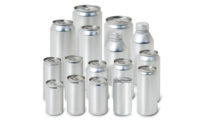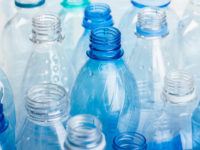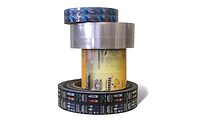How a beverage is packaged and deciding the type of packaging material — glass, aluminum or plastic — is a critical part of the equation for beverage-makers. Among the factors that should be considered is sustainability, cost, design, smaller packaging sizes, and lightweighting, or reducing the overall weight of a beverage container.
Franck Hancard, packing product and process director at Sidel, notes that the liquid packing industry is taking a more holistic approach to packaging materials.
The Octeville-sur-Mer, France-based company offers X-LITE Still, a 500-ml PET packaging solution for non-pressurized still water that weighs only
6.5 grams at a height of 195 mm, while being compatible with rPET, recycled PET.
“Compared to bottles weighing 12 grams, the solution is saving 1,485 tons of PET per year and generating energy savings of up to 335,000 kilowatts a year,” Hancard says. “Combined, these reductions amount to 3,000 less tons of carbon dioxide.”
In addition to lightweighting, the technology to produce PET bottles has drastically changed, saving time, energy and money. ”In the past, normal blow-mold air pressures to produce PET bottles were typically 35 to 40 bar (510 to 590 psi),” Hancard explains. “The lightweighting of the containers, particularly for water bottles, has reduced the final blow pressure to the 20 to 25 bar (290 to 365 psi) range. This lower pressure significantly lowers the volume of air needed to blow the bottle.”
When it comes to packaging materials, Megan Sanford, director of marketing operations at Ball Corp., notes that sustainability isn’t just a trend for the Westminster, Colo.-based company, “It serves as a foundation for our business,” she says.
“Aluminum is a fully recyclable, mono-material that is easy to sort and recycle,” Sanford says. “Aluminum cans have the lowest full recycling costs of any beverage packaging substrate; in fact, there is a net cost benefit to collect, sort and recycle aluminum cans. Metal drives the packaging recycling stream, and holds its value.
“We do our best to enhance the inherent sustainability attributes of aluminum by driving innovation to support the most sustainable beverage package available on the market,” she continues. “For example, lightweighting is a key part of what we do at Ball. The average aluminum beverage can weighs 40 percent less than it did in the 1970s when we first started tracking this type of data. Today, aluminum cans are one of the lightest beverage packages while remaining extremely strong and protective of their contents.”
Robert Budway, president of the Can Manufacturers Institute (CMI), Washington, D.C., points out that aluminum cans lead the way when it comes to the features that matter most to consumers and brand owners: taste, branding, product protection, performance and sustainability.
“Aluminum cans offer many advantages, including the opportunity for 360-degree branding, the protection of products from air and light, and increased portability, which makes them perfect for today’s active consumer lifestyles,” Budway says. “Because of these many advantages and the desire for a product that is recycled at scale in the United States, beverage companies are purchasing more aluminum beverage containers. Our can shipment numbers show an increase of 3.5 percent in 2019 and of 5 percent just in the fourth quarter of last year.”
When it comes to plastic bottles, several trends in the beverage industry also are impacting the primary packaging solution including negative media and consumer perception of plastic as non-biodegradable and its unsustainability aspect, says Michael Zuckerman, president of Zuckerman Honickman (ZH), King of Prussia, Pa.
“[Beverage manufacturers] are requesting more PET bottles with post-consumer recyclable (PCR) plastic resin to be more sustainable, but they are often deterred by the increased cost of the PCR resin,” Zuckerman says.
Yet, many big beverage companies like The Coca-Cola Co., PepsiCo, and Keurig Dr Pepper — through the Every Bottle Back initiative enacted in 2019 — are spearheading the recycling of containers and educating consumers about the recyclability of plastic bottles and more.
In 2019, Sidel became a new signatory on the Plastics Economy Global Commitment. The worldwide initiative was launched by the Ellen MacArthur Foundation and UN Environment in 2018 with the goal of addressing the pollution crisis at its source and keeping plastics within the economy. Today, it unites more than 400 organizations on its common vision of a circular economy for plastics.
Industry innovations
In order to provide consumers with more sustainable solutions, suppliers are continually researching and releasing new products to help protect the planet.
For instance, Purchase, N.Y.-based PepsiCo Beverage North America is testing 100 percent recyclable alternatives to plastic rings in the Sacramento market. It is using paperboard and molded pulp rings on its 7.5-ounce mini can six-packs of Pepsi and Sierra Mist. Both options are recyclable, and the molded pulp option also is compostable and biodegradable in a commercial system, it adds.
“We understand the growing concern around the use of plastic packaging, which is why we’re developing and testing different packaging options as alternatives to plastic rings,” said Emily Silver, vice president of innovation and marketing capabilities at PepsiCo Beverages North America, in a statement. “It’s the right thing to do for our consumers, our business and our planet.”
When it comes to the recyclability of cans, CMI’s Budway notes that the vast majority of recycled beverage cans are turned into new cans, “making it the textbook example of the circular economy,” he says.
Budway also points out that the recycled content of aluminum cans in the United States averages around 73 percent, and offers an intrinsic value of more than $1,000 per ton, which makes it the most valuable material in the recycling stream.
Aluminum cans also are effective at protecting contents from air and light. “The two biggest enemies for any beverage is light and oxygen,” Budway explains. “Aluminum cans are supremely effective in keeping out these damaging elements, locking in flavor better than any other packaging type.”
Experts note that the clear glass bottle, with its high premium look and feel, and its literal transparency caters to the product and promotes a feeling of honesty and authenticity. Glass also is 100 percent recyclable and is often the No. 1 choice of craft distilleries and wineries looking to package their premium products in a premium, distinctive package.
“Glass bottles offer opportunities for vintage-style packaging and product lines … and can be used for virtually all types of beverages without worrying about barrier properties or contamination through chemical reactions with the packaging material,” Sidel’s Hancard says.
He also notes that reusable glass bottles are gaining popularity over single-use glass bottles to help reduce waste, improve recycling steams as well as lower the carbon footprint. “Return and refilling schemes, however, necessitate the use of rather neutral bottles, shifting the design focus from the bottle itself to the label and cap,” he says.
With the ever-increasing focus on environmental responsibility, especially renewable materials, experts note that primary packaging could increasingly move to cartons and other plant-based sources. Yet, ZH’s Zuckerman notes that “plant-based resins are expensive and not yet practical for liquids.”
As the materials market moves forward, Zuckerman wonders how Americans will weigh the cost between lower material product cost and saving the environment for future generations.
“We have a sustainable program at ZH focusing on both pulp containers and utilizing PET and making it more sustainable,” he says. “The United States needs to focus on the above along with increasing the recycling stream.”




